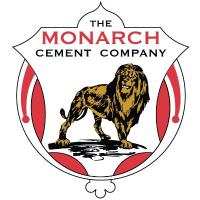 stockpickerup
11 years ago
stockpickerup
11 years ago
Cement A Possible 60% Total Return
I own shares in this stock and was away on vacation or traveling the past month, but initially intended to post this when stock was $26 early August before their 10-Q for June 30. Despite stock up 12% since then, the potential remaining upside could be 60% total return including stock dividend (3.2% yield) over next two years. $45 price target along with 3.2% dividend yield from current $29.00 price.
Beware of two major risks of illiquidity in the shares and of disaster (explosion, fire, flood, major storm, tornado) impact on their sole plant in Kansas. Insider ownership is very high with the family and management owning approximately 19% of one class (OTCQB:MCEM) and 39% of the other class of shares (OTC:MCEMB). This, along with the shares traded OTC (over-the-counter), cause weeks to build a stake and even some wide bid/ask spreads occasionally.
Monarch Cement (OTCQB:MCEM) is a one hundred year old company with one large plant making ready-mix and cement, as well as cement concrete products. They produce and sell in the Midwest. Revenues are fairly evenly split between ready-mix and concrete (Portland cement and Masonry cement along with concrete products). The cement side is more interesting than ready-mix because of better margins (gross margins are two to three times higher in cement than ready-mix).
Environmental regulation pressures by the EPA (NESHAP) that triggered heavy capital expenditures the past couple years for compliance of pollution and emissions given mostly coal/coke fuel for manufacturing. Monarch Cement has already spent $17 million on this, which is a lot considering the market cap was only $100 million early August and little net debt ($14 million excluding pension/post retirement obligations of $32 million, but nearly $30 million in equity investments that could mostly offset it). Monarch Cement might have to spend another $11 million total for final compliance but also includes some spending on more modernization and efficiency. Their plant facility is more modern now but this EPA compliance pressure has put some smaller plants or competitors out of business in the US. My thesis is that a few peers have dropped out and the cement plants need to eventually pass along some of these compliance costs, so cement pricing could increase by 15% from summer 2014 to summer 2016. This provides a nice tailwind to operating leverage and the increase in capacity utilization in the peak season period (April-September). Should get a nice free cash flow and margin lift when it completes this emissions compliance spending in a few quarters.
Non-residential construction recovery is a critical part of the thesis as highways, bridges and roads need to be constructed and repaired. Residential housing recovery and even commercial construction improvement also contribute to ends needs of cement and ready-mix in concrete. Real construction spending in their region could grow 8-9% the next couple years or even higher including potential cement price increases.
June 30 quarter results had gross margins up to 25.5% from 20.5% a year ago due to cement side profitability expansion. Cement volumes rose 27% in June quarter, although easy year-ago comparison and weak first quarter ending March from annual downtime maintenance and repair made such sequential improvement possible. Ready-mix volumes rose nearly 13% but margins were slightly down there and still a concern.
It is not much of a stretch to envision $30 million of EBITDA potential despite some small divestiture/exit of two small business lines over the past year. Supply constraints and price increases over the next two years should help them possibly achieve this.
Replacement cost of their plant today could be $350-$400 million and tough entry barriers with permitting, compliance and geographical distribution radius constraints of maybe 300 miles where transportation costs are still economical.
A couple recent public M&A transactions sold for about 2.3x revenues. I imagine Monarch Cement could achieve $155 million revenues in 2017. Unclear if it is a takeover candidate due to high insider ownership and large voting impact (mainly from B shares). Their large plant with 1.1 million tons of cement capacity per year along with 250 acres of land for cement terminal, rock quarry minor acreage (although contracted to 3rd party) and equity investments could be attractive to Lafarge, Martin Marietta Materials/Texas Industries, Holcim, Eagle Materials, Vulcan Materials, Cementir, Cemex, Heidelberg Cement or Vicat S.A.
Valuation is cheap here at $29 stock price. I averaged three approaches of 6.5x $30 million EBITDA potential, $350 million replacement value at today's new costs and 2.3x recent peer transactions on $155 million revenue potential. This equates to roughly $300 million enterprise value versus $128 million today. Even using 6.6x potential $30 million EBITDA would be 55% upside before dividends that might add an additional 5-6% for 60% total return.
Lastly, there is no active sellside analyst coverage on this stock being published. I have not seen any sellside report on it. The company only publishes quarterly 10-Q and an annual report, but no quarterly results press release. This stock is very overlooked. 3.2% dividend yield, $30 million in equity investments as of June 30 (versus market cap $114 million) and some interesting tailwinds noted above make it very compelling. Liquidity remains an issue given OTC trading and high insider ownership. It has seasonal highs of revenues April-September then slows down during winter months due to less construction. Long-term highway funding is still a question mark, but seems fine through May '15 and hopeful longer term solution in place by then. Patience could be rewarded.
Disclosure: The author is long MCEM.

 LouisDesyjr
8 years ago
LouisDesyjr
8 years ago
 Nutinfancy
10 years ago
Nutinfancy
10 years ago
 stockpickerup
11 years ago
stockpickerup
11 years ago
